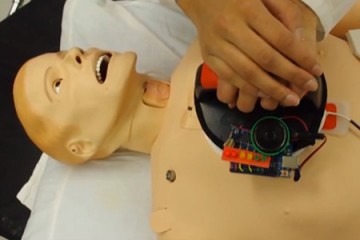A Johns Hopkins biomedical engineering student team earned first prize in the undergraduate division of the national Collegiate Inventors Competition with a system it devised to improve the way lifesaving shocks are delivered to hearts. In the graduate-level competition, Isaac Kinde, a Johns Hopkins medical student, received third-place honors for developing, as part of a team at the Johns Hopkins Kimmel Cancer Center, a test to detect ovarian and endometrial cancers.
Winners in the competition, conducted by Invent Now and the National Inventors Hall of Fame, were announced Nov. 12 after the finalists presented their projects at the U.S. Patent and Trademark Office in Alexandria, Va. After the judging, all finalists were invited to the White House to meet with John Holdren, a senior adviser to President Barack Obama on science and technology.
This was the second consecutive year that a Johns Hopkins undergraduate BME team finished first in its division.
"There were a lot of projects that were technologically complex," says team member Sandya Subramanian, "but our device is simple. That means clinicians are more likely to use it."
The team's PrestoPatch system is designed to be used during the administration of electric shocks to patients experiencing arrhythmia, an erratic heartbeat that can be fatal. In existing treatments, the doctor must decide where to place two electrode patches: on the front, side, or back of the patient. The electric current passes through the heart as it moves between the two electrodes; if the first shock does not work, the patches cannot be moved to a new position that might yield better results. But the PrestoPatch system allows the doctor to attach three patches instead of two; if the first shock doesn't help, the doctor can quickly flip a switch and change the current's path through the body.
A second part of the system addresses impedance, a problem that occurs when the patient's body resists the lifesaving current. Doctors currently try to overcome this by pressing down on a patch with their fists. To improve on this crude method, the students devised a manual tool that applies the pressure in a standardized way; lights on the tool alert the doctor when the proper pressure is applied.
The PrestoPatch team members—Piyush Poddar, Aaron Chang, Kevin George, Peter Malamas, Melinda Chen, Rohil Malpani, Joon Eoh, and Subramanian—say they plan to use their $12,500 prize money to help launch a company aimed at moving their invention forward.
The team's sponsor was Todd J. Cohen, who earned his undergraduate and medical degrees at Johns Hopkins and who now is director of Electrophysiology at Winthrop University Hospital in Mineola, N.Y. The project emerged from the undergraduate design team program offered by the Department of Biomedical Engineering, which is shared by the schools of Medicine and Engineering. The work is conducted within the Center for Bioengineering Innovation and Design. The team's faculty adviser was Robert Allen.
Johns Hopkins medical student Kinde, who was honored in the graduate division of the contest, used cervical fluid obtained during routine Pap tests in the development of a new test to detect ovarian and endometrial cancers. In a pilot study, the PapGene test, which relies on genomic sequencing of cancer-specific mutations, accurately detected all 24 (100 percent) of endometrial cancers and nine of 22 (41 percent) ovarian cancers.
Kinde and his colleagues say larger-scale studies are needed before clinical implementation can begin, but they believe the test has the potential to pioneer genomic-based cancer screening tests.
According to the investigators, PapGene is a high-sensitivity approach for the detection of cancer-specific DNA mutations; however, false mutations can be erroneously created during the many steps—including amplification, sequencing, and analysis—required to prepare the DNA collected from a Pap test specimen for sequencing. This required the investigators to build a safeguard into PapGene's sequencing method, designed to weed out artifacts that could lead to misleading test results.









